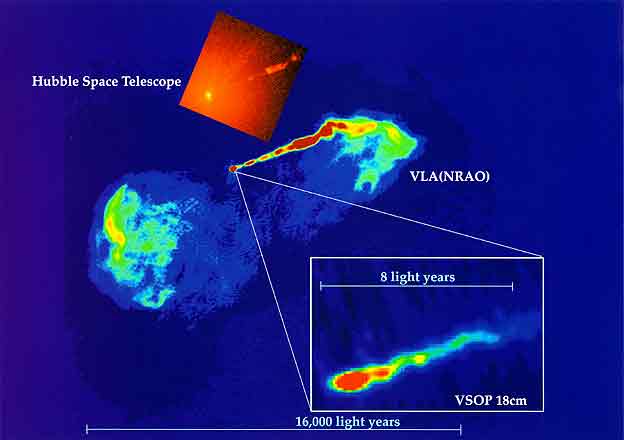 In the direction of the Virgo and Coma constellations, about 50million light years from our galaxy, there is a cluster of about 2500 galaxies. At the center of this cluster is the huge elliptical galaxy M87. It has been known for over 80 years that an optical jet roughly 10,000 light years long is being shot out of the center of this galaxy. Observations of the core of M87 with the Hubble Space Telescope revealed spectra indicating that material was revolving around the jet axis and around a central mass of 2.4 billion solar masses. If this is a black hole, its radius (Schwarzschild radius) of 7 billion kilometers would fit inside the orbit of Pluto.
In the direction of the Virgo and Coma constellations, about 50million light years from our galaxy, there is a cluster of about 2500 galaxies. At the center of this cluster is the huge elliptical galaxy M87. It has been known for over 80 years that an optical jet roughly 10,000 light years long is being shot out of the center of this galaxy. Observations of the core of M87 with the Hubble Space Telescope revealed spectra indicating that material was revolving around the jet axis and around a central mass of 2.4 billion solar masses. If this is a black hole, its radius (Schwarzschild radius) of 7 billion kilometers would fit inside the orbit of Pluto.
 A radio jet resembling the optical jet can also be seen. An observation of the base of the M87 jet was conducted at a wavelength of 18cm with HALCA and the Very Long Baseline Array (VLBA). With a resolution of 1 milli-arcsecond, the observation probe the jet on the 0.25 light-year scale. This corresponds to only 300 times the diameter of the supposed central black hole. The jet shows evidence of an oscillation, consistent with a spiral structure with a pitch of about1 light-year. This structure can be seen extending 10 light-years from the core. This thin jet extends several thousands of light-years without the spiral becoming any wider and how this confinement occurs is of great interest to astronomers.
A radio jet resembling the optical jet can also be seen. An observation of the base of the M87 jet was conducted at a wavelength of 18cm with HALCA and the Very Long Baseline Array (VLBA). With a resolution of 1 milli-arcsecond, the observation probe the jet on the 0.25 light-year scale. This corresponds to only 300 times the diameter of the supposed central black hole. The jet shows evidence of an oscillation, consistent with a spiral structure with a pitch of about1 light-year. This structure can be seen extending 10 light-years from the core. This thin jet extends several thousands of light-years without the spiral becoming any wider and how this confinement occurs is of great interest to astronomers.
 VSOP studies of this source continued with observations at a wavelength of 6cm. This improved the resolution by a factor of three, and allowed the structure to be studied on a scale only 100 times the diameter of the suspected black hole. Furthermore, in order to study changes in the jet structure, VSOP observations of M87 have been carried out four times. On a much larger scale, Hubble Space Telescope observations showed evidence for jet components moving at an apparent speed of six times the speed of light. Such motions would be easily seen in VSOP observations if they took place this close in to the jet, but they are not seen at all! One possible explanation is that the radio emission is coming from slow-moving shocks at the edges of the jet, but that the underlying jet speed, revealed in the HST observations, is much higher.
VSOP studies of this source continued with observations at a wavelength of 6cm. This improved the resolution by a factor of three, and allowed the structure to be studied on a scale only 100 times the diameter of the suspected black hole. Furthermore, in order to study changes in the jet structure, VSOP observations of M87 have been carried out four times. On a much larger scale, Hubble Space Telescope observations showed evidence for jet components moving at an apparent speed of six times the speed of light. Such motions would be easily seen in VSOP observations if they took place this close in to the jet, but they are not seen at all! One possible explanation is that the radio emission is coming from slow-moving shocks at the edges of the jet, but that the underlying jet speed, revealed in the HST observations, is much higher.

